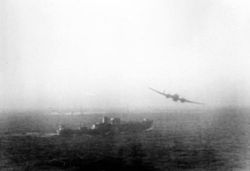| Operation Orator | |||||||
|---|---|---|---|---|---|---|---|
| Part of Arctic naval operations of the Second World War | |||||||
 A Hampden TB.1 of the Leuchars Wing makes a torpedo attack on a German vessel during the Second World War. (A photograph taken by a member of 18 Group on an unrelated operation.) | |||||||
| |||||||
| Belligerents | |||||||
|
|
| ||||||
| Commanders and leaders | |||||||
|
|
| ||||||
| Units involved | |||||||
|
Search & Strike Force
|
Marinegruppenkommando Nord (Naval Group Command North) Jagdgeschwader 5 (Fighter Wing 5) | ||||||
| Strength | |||||||
|
RAAF–RAF 32 long-range torpedo bombers 8 long-range maritime patrol aircraft 5 long-range reconnaissance aircraft |
Kriegsmarine 1 battleship (Tirpitz) 3 cruisers (Admiral Scheer, Admiral Hipper, Köln) 4 destroyers Luftwaffe 35–60 fighters (II./JG 5 and III./JG 5) | ||||||
| Casualties and losses | |||||||
|
Air crew killed: c. 18 POW c. 12 Aircraft: 9 torpedo bombers (en route to USSR) 2 PRU Spitfires | |||||||
Operation Orator was the code name for the defence of the Allied Arctic convoy PQ 18 by British and Australian air force units, based temporarily in North-West Russia, against attack by the German battleship Tirpitz and other Kriegsmarine surface vessels. The wing, known as the Search & Strike Force, was commanded by Group Captain Frank Hopps and its maritime strike element was the Leuchars Wing, comprising No. 144 Squadron, Royal Air Force (RAF) and No. 455 Squadron, Royal Australian Air Force (RAAF) equipped with Handley-Page Hampden TB 1 torpedo bombers.
The Hampden crews made a long and dangerous flight from bases in Scotland (4–5 September) and assembled at Vaenga airfield on the Kola Inlet, 25 mi (40 km) north of Murmansk. The two squadrons lost nine aircraft shot down or crashed in transit but the remainder joined a detachment of 210 Squadron Catalina flying boats and a section of photographic reconnaissance Spitfires from 1 Photographic Reconnaissance Unit to make up the Search & Strike Force (S&SF).
At 7:30 a.m. on 14 September, 23 Hampdens were scrambled, after Tirpitz was reported absent from its moorings. The Hampdens flew to the maximum distance that Tirpitz could have reached then turned to follow the track back to Altafjord, as far as the Catalina cross over patrols. After an uneventful flight, the Hampdens returned at 3:00 p.m. from what turned out to be a false alarm; Tirpitz having moved to a nearby fjord. The S&SF Hampdens stayed at readiness and the Spitfires watched over Tirpitz until October. Operation Orator had deterred the Germans from risking their capital ships against PQ 18 and after converting the Soviet Air Forces (VVS) to the Hampden and Spitfire aircraft to be left behind, the aircrew and ground personnel returned to Britain.
- ^ Schofield & Nesbit 2005, p. 195.
Cite error: There are <ref group=lower-alpha> tags or {{efn}} templates on this page, but the references will not show without a {{reflist|group=lower-alpha}} template or {{notelist}} template (see the help page).
© MMXXIII Rich X Search. We shall prevail. All rights reserved. Rich X Search
